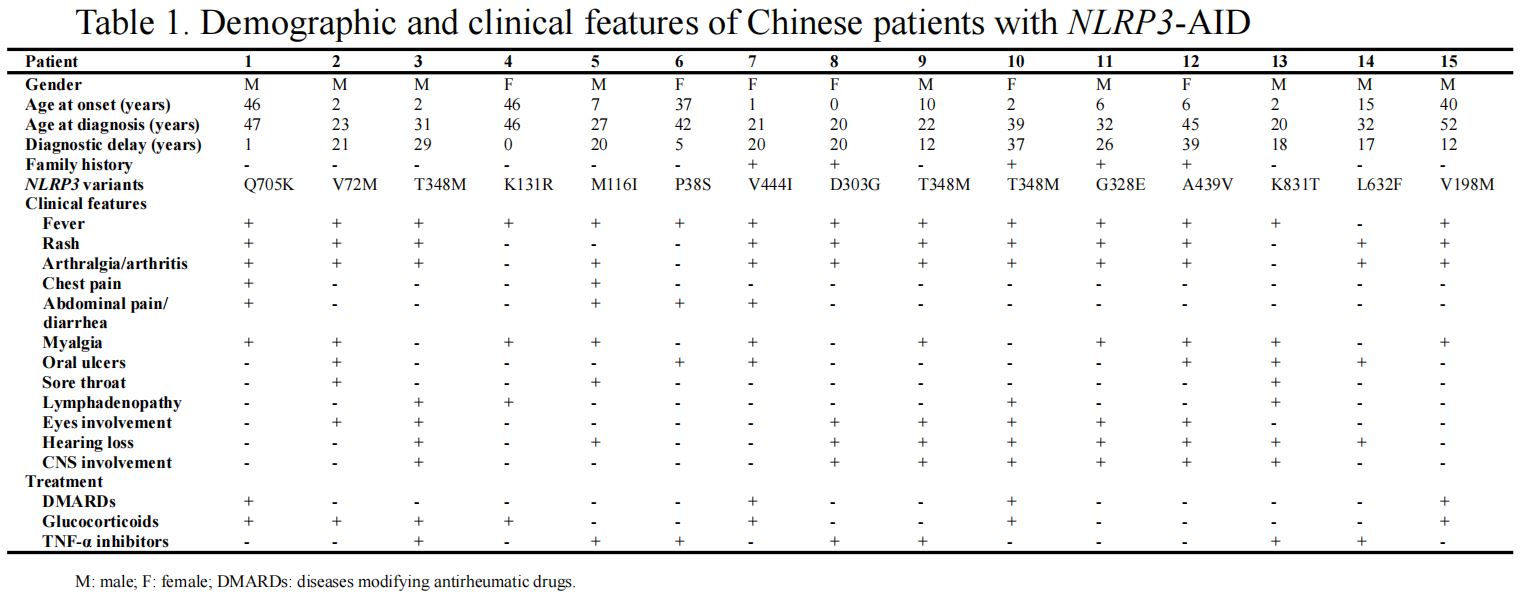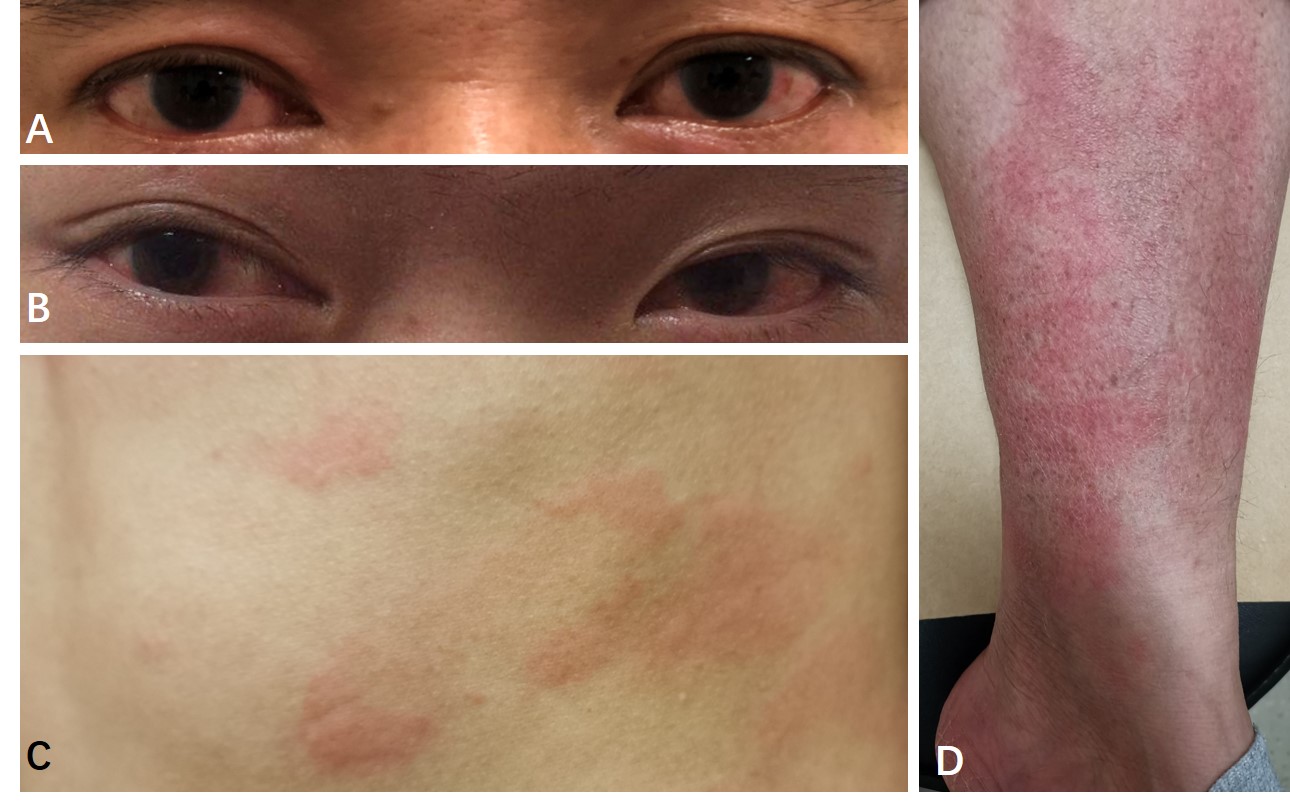Session Information
Date: Monday, November 8, 2021
Session Type: Poster Session C
Session Time: 8:30AM-10:30AM
Background/Purpose: NLRP3-associated autoinflammatory disease (NLRP3-AID, OMIM 606416), previously called cryopyrin-associated periodic syndrome (CAPS), is a spectrum of autosomal dominant inherited diseases associated with NLRP3 gene mutations, leading to the overactivation of NLRP3 inflammasome and the excessive release of interleukin (IL)-1β. NLRP3-AID encompasses three conditions of of increasing severity: familial cold-induced autoinflammatory syndrome (FCAS), Muckle-Wells syndrome (MWS), and chronic infantile neurological cutaneous articular syndrome (CINCA). We aim to report a cohort of Chinese adult NLRP3-AID patients.
Methods: This single-center study included fifteen adult patients diagnosed with NLRP3-AID at Department of Rheumatology, Peking Union Medical College Hospital between July 2015 to September 2020. Demographic information and detailed clinical records were carefully documented and studied. Whole-exome sequencing using next-generation sequencing was performed in each patient.
Results: These 15 patients were all diagnosed as MWS. Of them, the gender ratio of male to female was 3:2. All patients were of Chinese Han ethnicity. The median age of disease onset was 16 (0-46) years old, and adult-onset was observed in 4 patients (26.7%). The median time of diagnosis delay was 20 (0–39) years. 5 patients (33.3%) had positive family history of similar symptoms. The most common clinical manifestations were fever (93.3%), arthritis (80.0%), rash (73.3%), myalgia (66.7%), hearing loss (60.0%) and central nervous system involvement (53.3%). No patient developed renal amyloidosis. Acute phase reactants (CRP 80.3 ±51.0 mg/L and ESR 52 ± 28 mm/h) elevated during flares in all patients and normalized during intervals. Rarely, a 38-year-old female patient presented with positive ANA and antiphospholipid antibodies, which were negative in the other patients. Heterozygous NLRP3 variants confirmed in these patients were T348M (n=3), Q703K, V70M, K131R, M116I, P38S, V444I, D303G, G328E, A439V, K831T, L632F and V198M (n=1, separately). Patients with T348M mutation showed more severe organ damage, including the eyes and the central nervous system. Glucocorticoids were given to 7 patients with partial symptom relief in 6 patients (71.4%). Due to the unavailability of IL-1 inhibitors in China, TNF-α inhibitors (etanercept and adalimumab) were used in 7 patients with effective responses (100%).
Conclusion: We reported a large case series of Chinese adult NLRP3-AID patients. The distinct symptoms of NLRP3-AID patients suggest the heterogeneity of disease. K131R、M116I、P38S、V444 and K831T are identified as novel NLRP3 mutations. These data expanding the clinical phenotype and genotype profile of NLRP3-AID.
 Table 1. Demographic and clinical features of Chinese patients with NLRP3-AID
Table 1. Demographic and clinical features of Chinese patients with NLRP3-AID
 Figure 1. A.&B. Ocular inflammatory manifestations in Patient 9 and Patient 11; C. Erythematous rashes on the trunk of patient 5; D. Papules on the right lower limb of Patient 10.
Figure 1. A.&B. Ocular inflammatory manifestations in Patient 9 and Patient 11; C. Erythematous rashes on the trunk of patient 5; D. Papules on the right lower limb of Patient 10.
To cite this abstract in AMA style:
Wu N, Wu D, Miao J, Zhao M, Shen M. Phenotypes and Genotypes of NLRP3-AID in Chinese Adult Patients [abstract]. Arthritis Rheumatol. 2021; 73 (suppl 9). https://acrabstracts.org/abstract/phenotypes-and-genotypes-of-nlrp3-aid-in-chinese-adult-patients/. Accessed .« Back to ACR Convergence 2021
ACR Meeting Abstracts - https://acrabstracts.org/abstract/phenotypes-and-genotypes-of-nlrp3-aid-in-chinese-adult-patients/
